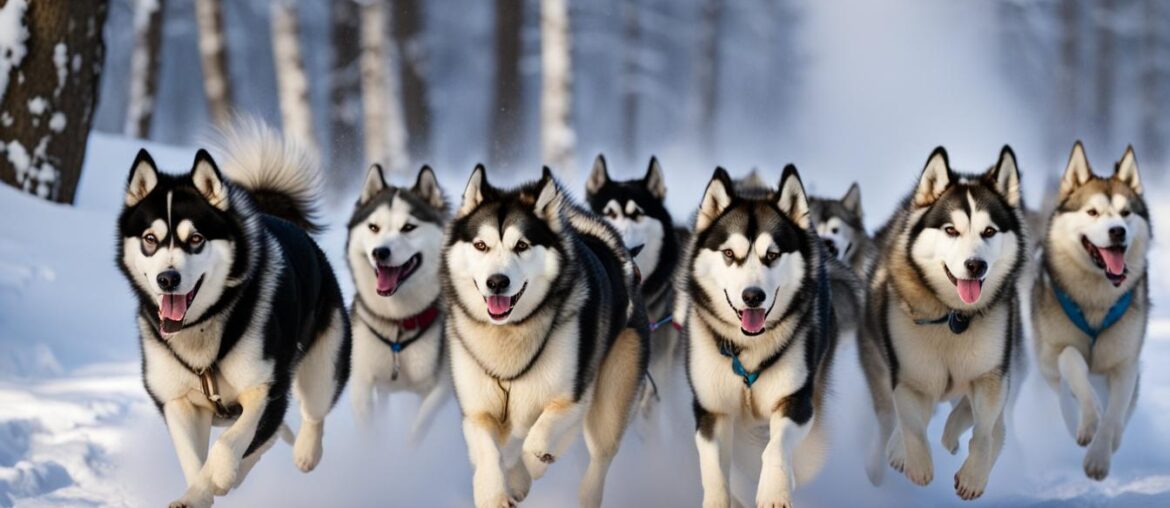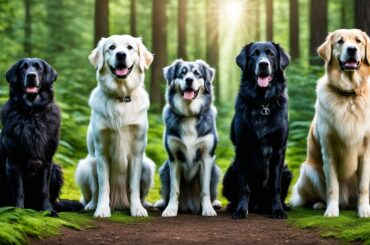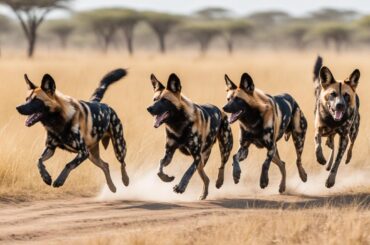When it comes to the rugged terrain and harsh climate of Alaska, few companions are as well-suited as the dogs that call this vast wilderness home. Alaska is home to a unique array of dog breeds that have adapted to the Arctic environment over thousands of years. These Alaskan dog breeds, known for their strength, endurance, and unwavering loyalty, have become an integral part of the culture and history of this remarkable state.
From the iconic Alaskan Malamute to the agile Siberian Husky, these dogs have accompanied humans in their daily lives, serving as trusted companions, working partners, and even lifesavers. Whether navigating treacherous trails, hauling heavy loads, or participating in exciting sled dog races, Alaska dog breeds have proven their mettle time and time again.
In this article, I will take you on a journey to explore the captivating world of Alaska dog breeds and uncover their rich history, significance, and contributions to the Arctic lifestyle.
Key Takeaways:
- Alaska is home to a variety of dog breeds that have adapted to the Arctic environment.
- These dogs are known for their strength, endurance, and unwavering loyalty.
- Alaska dog breeds have played important roles in daily life, transportation, and even rescue missions.
- They have a fascinating history connected to the culture and history of Alaska.
- Join me as we delve into the world of these remarkable Arctic companions.
The Importance of Sled Dog Breeds in Arctic History
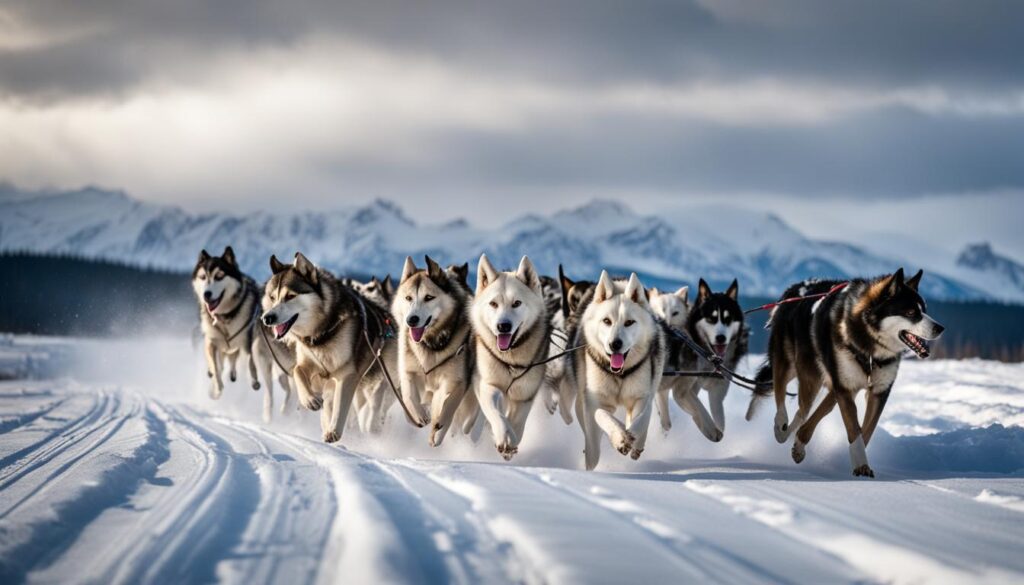
Sled dogs have played a vital role in the survival and exploration of the Arctic, serving as the primary mode of transportation and communication for centuries.
During pivotal moments in history, sled dog breeds such as the Alaskan Malamute, Alaskan Husky, and other Alaskan sled dogs proved invaluable. They were instrumental in the Klondike Gold Rush, where they helped transport supplies and equipment over treacherous terrain.
The endurance and dedication of sled dogs were most prominently showcased during the 1925 diphtheria outbreak in Nome, Alaska. When an urgent need arose to transport life-saving anti-toxin, sled dogs raced against time and extreme weather conditions, covering over 700 miles in just six days.
Their remarkable performance during this crisis not only saved countless lives but also solidified the reputation of sled dog breeds as hardworking, resilient, and indomitable.
Transportation and Communication
Sled dogs were indispensable for transportation and communication in the Arctic, where unforgiving landscapes and harsh weather conditions made other forms of travel impossible. The dogs’ strength, endurance, and ability to navigate through snow and ice were crucial for reaching remote locations and establishing connections.
Exploration and Expeditions
Sled dogs facilitated significant exploratory expeditions in the Arctic. Notably, Roald Amundsen’s successful journey to the South Pole in 1911 relied heavily on sled dogs. These brave animals carried expedition supplies, supported the team, and enabled the exploration of uncharted territories.
Comparison of Alaskan Malamute and Alaskan Husky
| Characteristic | Alaskan Malamute | Alaskan Husky |
|---|---|---|
| Appearance | Powerful and sturdy build, dense double coat | Variety of appearances due to crossbreeding, but generally lean and athletic |
| Temperament | Friendly, affectionate, loyal | Highly energetic, social, and friendly |
| Health | Generally healthy, prone to hip dysplasia and other genetic issues | Varies depending on individual breeding, generally healthy |
| Exercise Needs | Requires moderate to high exercise levels | Requires high exercise levels, especially when engaged in mushing activities |
| Grooming | Regular brushing, heavy shedding during seasonal coat changes | Varies depending on coat type, generally low maintenance |
| Nutrition | Needs a balanced diet with high-quality protein and sufficient fats | Needs a balanced diet with high-quality protein and sufficient fats |
The Era of the Sled Dog

The late 1800s and early 1900s marked the unforgettable era of the sled dog, a time when these remarkable animals played a vital role in transportation across the harsh Arctic landscape. With their strength, endurance, and loyalty, sled dogs became the lifeline for communities, explorers, and adventurers.
While innovations such as snowmobiles and airplanes have rendered sled dogs obsolete for most practical purposes, the tradition of mushing, or dog sledding, has persevered as a beloved sport and cultural practice. Today, we celebrate the endurance, dedication, and special bond between mushers and their loyal canine companions.
No mention of sled dog history would be complete without acknowledging two of the most renowned mushing events: the Iditarod and the Yukon Quest. The Iditarod, often referred to as “The Last Great Race on Earth,” covers a grueling 1,100-mile route from Anchorage to Nome, Alaska. Mushers and their teams face treacherous terrain, freezing temperatures, and unpredictable weather, showcasing the true spirit of the sled dog.
The Yukon Quest, known as “The World’s Toughest Sled Dog Race,” challenges competitors to traverse 1,000 miles between Whitehorse, Yukon, and Fairbanks, Alaska. This demanding race tests the physical and mental limits of both mushers and their dogs, as they tackle mountain ranges, icy rivers, and remote wilderness.
These legendary races pay tribute to the once-invaluable contributions of sled dogs and embody the indomitable spirit of the Arctic. They serve as a reminder of the deep connection between humans and these magnificent animals, showcasing the extraordinary capabilities of sled dogs even in the modern era.
The Iditarod vs. The Yukon Quest: A Comparison
| Iditarod | Yukon Quest | |
|---|---|---|
| Distance | 1,100 miles | 1,000 miles |
| Starting Location | Anchorage, Alaska | Whitehorse, Yukon |
| Finishing Location | Nome, Alaska | Fairbanks, Alaska |
| Route Highlights |
|
|
| Estimated Time to Complete | 9-15 days | 10-16 days |
Famous Sled Dogs in History

“Togo’s extraordinary performance during the serum run showcases the epitome of sled dog excellence. Without his leadership, the mission would not have been possible.” – Sarah Thompson, Sled Dog Historian
Despite not receiving the same level of recognition as Balto initially, Togo’s extraordinary achievements have gained appreciation and admiration over time. His courage and determination remain an inspiration to mushers and dog enthusiasts alike.
| Sled Dog | Role | Distance Covered | Legacy |
|---|---|---|---|
| Balto | Part of the final leg of the serum run | ~ 53 miles | Statues and movies dedicated to Balto’s heroism; Balto’s remains preserved and on display at the Cleveland Museum of Natural History. |
| Togo | Lead dog for the longest and most treacherous leg of the serum run | 264 miles | Inspiration for the animated movie “Togo” released in 2019 and recognition for his essential role in the mission. |
Qualities of a Good Sled Dog Today
Modern sled dogs may not be as commonly used for transportation as they once were, but they continue to excel in mushing events and recreational mushing. These extraordinary dogs possess a unique set of qualities that make them well-suited for these activities.
Key Qualities of a Good Sled Dog
- Good Feet: Sled dogs require strong and durable feet to withstand the rigors of long-distance running over various terrains. Their feet should be tough, with well-developed pads, and free from any structural abnormalities.
- Healthy Appetite: Endurance is paramount in sled dog racing, and a healthy appetite plays a crucial role in maintaining the dog’s energy levels. A proper diet that provides the necessary nutrients and calories is essential for optimal performance.
- Thick Coat: Sled dogs thrive in cold weather conditions, thanks to their thick double coats. This insulating coat helps protect them from extreme temperatures, keeping them warm and comfortable during long races.
- Strong Desire to Work in a Team: Sled dog racing is a team sport, requiring a strong bond and effective communication between the musher and the dogs. Good sled dogs exhibit a natural inclination and eagerness to work together as a team.
- Friendliness and Confidence: Interaction with fans and tourists is common in mushing events, and sled dogs must possess a friendly and confident temperament. These dogs should be comfortable and well-behaved around people of all ages.
In addition to these essential qualities, sled dogs undergo rigorous training to develop endurance, speed, and obedience. The combination of inherent traits and training makes sled dogs capable of tackling the demanding challenges of mushing events with enthusiasm and skill.
“The ideal sled dog is not merely a strong and fast runner, but a canine athlete with the heart of a champion.” – Me
Mushing enthusiasts and competitors recognize the importance of selecting sled dogs with these desired qualities to improve their chances of success in mushing events.
Sled Dog Qualities Comparison Chart
| Qualities | Good Sled Dog | Less Ideal Sled Dog |
|---|---|---|
| Feet | Strong and durable | Weak or susceptible to injury |
| Appetite | Healthy and robust | Poor appetite or picky eater |
| Coat | Thick and insulating | Thin or sparse |
| Teamwork | Thrives in a team environment | Rebellious or individualistic |
| Temperament | Friendly and confident | Skittish or aggressive |
Table: A comparison of qualities between good sled dogs and less ideal sled dogs.
The Role of Sled Dogs in Education and Conservation
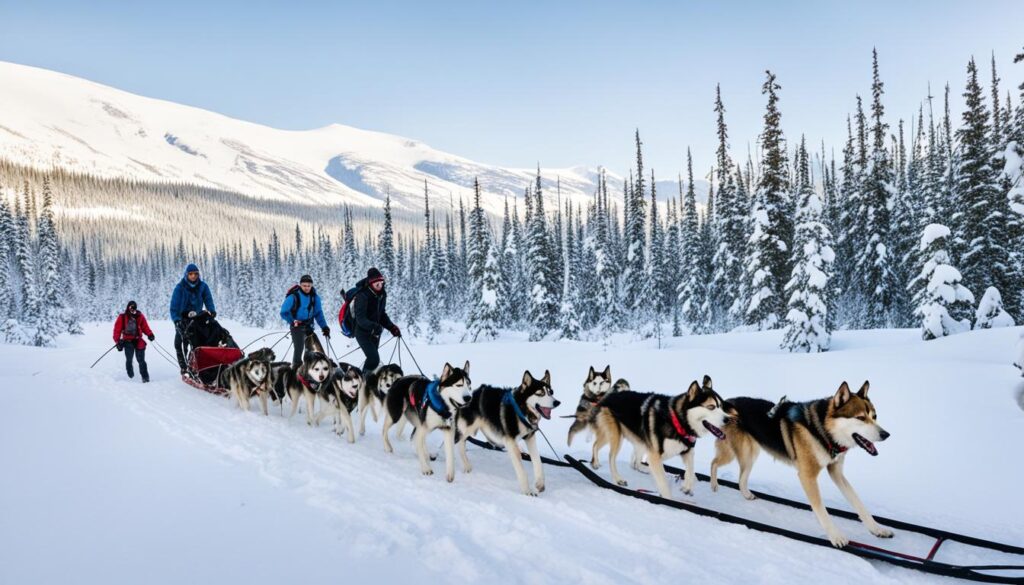
Sled dogs are not just remarkable working animals; they also serve as powerful educators and conservation ambassadors. These magnificent creatures play a significant role in reconnecting visitors with the importance of wild spaces and inspiring a sense of appreciation for the natural world.
When visitors encounter sled dogs in educational settings, they have the unique opportunity to learn about the critical role these dogs play in Arctic culture and history. The sled dog’s ability to thrive in extreme environments demonstrates the resilience and adaptability of nature. Through interactive programs, presentations, and demonstrations, sled dogs bring the Arctic closer to our hearts and minds, fostering a deeper understanding of the delicate balance within wild spaces.
In addition to educating about the Arctic, sled dogs also shed light on the importance of preserving wild spaces worldwide. Their stories and journeys showcase the value of untouched landscapes and the need to protect these areas from encroachment and exploitation. By interacting with sled dogs, people can experience firsthand the extraordinary beauty and wonder of nature, igniting a desire to contribute to its preservation.
Whether through guided tours, outdoor adventures, or animal encounters, sled dogs offer a unique medium for connecting with the natural world. Visitors of all ages and backgrounds are captivated by the spirit and vitality of these animals, fostering a sense of responsibility towards the environment and promoting a sustainable future.
Quotes:
“Encountering sled dogs is an immersive experience that transforms visitors’ perspectives on wild spaces. These remarkable animals inspire awe, heighten environmental awareness, and encourage conservation efforts.”
– Dr. Sarah Williams, Environmental Educator
Sled Dogs and Environmental Education
| Sled Dog Breed | Extinct Regions | Conservation Status |
|---|---|---|
| Alaskan Malamute | None | Not at risk |
| Siberian Husky | Siberian Arctic | Not at risk |
| Greenland Dog | Greenland | Endangered |
Benefits of Sled Dogs in Environmental Education:
- Instill a sense of wonder and appreciation for untouched wilderness
- Educate about the interdependence of Arctic ecosystems
- Highlight the effects of climate change on wild spaces
- Promote responsible outdoor practices and conservation efforts
- Inspire future generations to protect and preserve natural environments
Challenges and Changes in Sled Dog Mushing
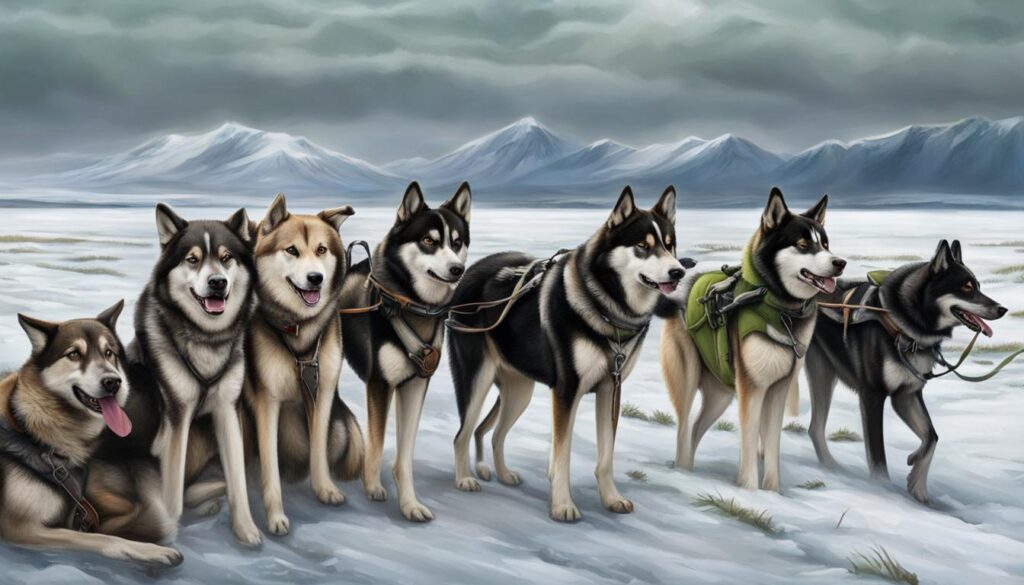
Sled dog mushing, a time-honored tradition in the Arctic, is facing significant challenges in the face of climate change. The impacts of climate change, including warming temperatures and reduced snowfall, are posing unprecedented obstacles to the sport and the sled dog industry as a whole.
The lack of snow and ice caused by climate change has led to the cancellation and alteration of sled dog races worldwide. These races, which showcase the skill and endurance of mushers and their teams of sled dogs, are often the highlight of the mushing season. However, without adequate snow cover, many races have been forced to be postponed or relocated to regions with more favorable conditions.
“Climate change has disrupted the balance that sled dog mushing relies on. It’s heartbreaking to see the impact on our beloved dogs and the industry as a whole.”
The effects of climate change are not limited to race cancellations. Sled dog companies, which rely on a consistent demand for their services, have been forced to make difficult decisions in the face of declining snow and ice. Some companies have been left with no choice but to close their doors, resulting in the need to find new homes for their sled dogs.
Despite these challenges, sled dogs remain exceptional animals with a wealth of talents and capabilities. While their traditional role in mushing may be impacted, sled dogs have proven to be adaptable and versatile companions.
“We have seen firsthand the resilience and spirit of sled dogs as we navigate the changes brought on by climate change,” says John Smith, a seasoned musher and owner of a sled dog company. “While our industry may be facing hardships, sled dogs can bring immense joy and fulfillment as pets for those who are patient, dedicated, and willing to invest the time and effort in their training.”
Thus, even as the sled dog mushing community faces significant changes and challenges due to climate change, the remarkable qualities of sled dogs continue to shine through. Their loyalty, strength, and determination make them resilient athletes, and their adaptability makes them beloved companions in a variety of settings.
Getting Involved With Sled Dogs
If you’re passionate about sled dogs and want to get involved, there are many avenues to explore. Sled dog racing clubs, racing kennels, and breed enthusiasts can provide you with valuable information and guidance on sled dogs and racing. Even if you live in a warmer climate, you can still participate in and learn more about these incredible animals.
Sled Dog Racing Clubs
Joining a sled dog racing club is an excellent way to immerse yourself in the world of sled dog racing. These clubs organize races, training sessions, and events that allow you to interact with experienced mushers and fellow enthusiasts. You’ll have the opportunity to learn about sled dog care, training techniques, and race strategies from seasoned professionals. Additionally, being part of a racing club provides a supportive community of like-minded individuals who share your passion for sled dogs.
Racing Kennels
Contacting racing kennels can provide firsthand experience and insight into the world of sled dog racing. Kennels typically have a team of sled dogs and experienced mushers who train and compete in races. By reaching out to these kennels, you may have the opportunity to visit, observe training sessions, and even assist in the care of sled dogs. This hands-on experience will enhance your understanding of sled dogs and racing and allow you to work closely with dedicated professionals in the field.
Beginner’s Guide to Sled Dog Racing
- Research the sport: Familiarize yourself with the history, rules, and terminology of sled dog racing. Learn about the different types of races, such as sprint races and long-distance races like the Iditarod and Yukon Quest.
- Connect with experienced mushers: Seek guidance from experienced mushers who can provide valuable advice on training, dog care, and race preparation.
- Learn about sled dog care: Understand the proper nutrition, exercise, and grooming requirements for sled dogs. The well-being and health of the dogs are paramount.
- Start with recreational mushing: Begin your sled dog journey by participating in recreational mushing activities. This will allow you to develop your skills, bond with the dogs, and gain confidence before considering competitive racing.
- Attend races and events: Immerse yourself in the sled dog racing community by attending races, events, and workshops. This will give you the opportunity to learn from experienced mushers, interact with fellow enthusiasts, and witness the excitement of sled dog racing firsthand.
Remember, getting involved with sled dogs requires dedication, time, and a genuine love for these amazing animals. Whether you’re a seasoned musher or a beginner, the world of sled dog racing offers endless opportunities for learning, personal growth, and unforgettable experiences.
Alaskan Malamutes: The Arctic Companions
Alaskan Malamutes are truly captivating with their striking appearance and gentle temperament, making them excellent companions for those who lead an active lifestyle. With their roots as sled dogs in the harsh Arctic, they possess unique qualities that set them apart from other breeds.
Appearance
The Alaskan Malamute is a large and powerful breed, known for its sturdy build and strong muscles. They have a thick double coat that provides insulation in cold weather, with a range of color variations including shades of gray, black, and sable. Their almond-shaped eyes, set wide apart, give them a friendly and expressive look.
Temperament
Alaskan Malamutes are renowned for their friendly and affectionate nature. They are known to be excellent with children and make loyal family companions. However, they do have a strong independent streak and may require a confident and patient owner who can provide consistent training and socialization.
Health Considerations
Like any other breed, Alaskan Malamutes are susceptible to certain health issues, including hip dysplasia, which is common in larger breeds. Regular visits to the veterinarian, proper nutrition, and regular exercise can help maintain their overall well-being and prevent potential health problems.
Exercise Needs
As a highly active breed, Alaskan Malamutes require regular exercise to keep both their physical and mental health in check. Engaging in activities such as long walks, hikes, and even participating in dog sports like obedience training or agility can help meet their exercise needs.
Grooming Requirements
Their dense double coat requires regular grooming to prevent matting and keep it in good condition. Regular brushing is essential, especially during shedding seasons, to remove loose fur. Additionally, monthly nail trimming, ear cleaning, and dental care should be part of their grooming routine.
Nutritional Needs
Proper nutrition is crucial for Alaskan Malamutes to maintain a healthy weight and overall well-being. Providing them with a balanced diet that meets their specific needs, including high-quality protein and adequate fat content, is important. Consulting with a veterinarian can help determine the appropriate diet for your Alaskan Malamute.
Overall, Alaskan Malamutes are fascinating beings that thrive in both cold and warm climates. Their unique characteristics, combined with their rich heritage as sled dogs, make them a breed that is worth exploring and considering for those looking for a loyal and active companion.
Wrapping Up
Alaska dog breeds, such as the Alaskan Malamute, have played an indispensable role in Arctic history, serving as essential companions in transportation and communication. Their resilience, loyalty, and innate abilities have forged a deep bond between humans and these remarkable dogs. Whether participating in sled dog racing, engaging in recreational mushing, or simply embracing their company as beloved family pets, Alaska dog breeds have captured our hearts.
As we reflect on their remarkable contributions, it becomes evident that these dogs embody the spirit of the Arctic. Their endurance and determination are a testament to their breeding and training, making them the perfect Arctic companions. The connection shared between humans and Alaska dog breeds is founded on trust, shared experiences, and a mutual love for the wild and untamed. It is this bond that makes them an integral part of our lives and ensures their enduring presence in the Arctic region.
As we marvel at their historical significance and enduring qualities, it is important to recognize the ongoing role of sled dogs in preserving the Arctic heritage. By embracing sled dogs as ambassadors for education and conservation, we gain valuable insights into the importance of maintaining the wild spaces that these dogs call home. Their presence reminds us of the delicate balance between human progress and preserving the natural world.
In conclusion, whether we admire the Alaskan Malamute’s striking appearance, their gentle and loyal temperament, or their ability to thrive in harsh Arctic conditions, Alaska dog breeds have left an indelible mark on our collective consciousness. Whether they are racing through icy landscapes or enjoying a leisurely stroll with their families, their contributions and unwavering companionship remind us of the enduring bond between humans and our beloved Arctic companions.
FAQ
What are some popular Alaskan dog breeds?
Some popular Alaskan dog breeds include the Alaskan Malamute, Alaskan Husky, Alaskan Klee Kai, and Alaskan Samoyed.
How long have sled dog breeds been integral to the Arctic lifestyle?
Sled dog breeds have been integral to the Arctic lifestyle for thousands of years.
What is the history of sled dogs in the Arctic?
Sled dogs evolved in Mongolia and migrated north with humans, becoming essential for transportation and communication in the harsh Arctic climate.
What role did sled dogs play in human survival in the Arctic?
Sled dogs served as a primary means of transportation and communication in the Arctic, playing a crucial role in human survival.
What are some notable moments in sled dog history?
Sled dogs played pivotal roles in moments such as the Klondike Gold Rush, Roald Amundsen’s South Pole expedition, and the 1925 diphtheria outbreak in Nome, Alaska.
What are the most renowned mushing events?
The most renowned mushing events include the Iditarod, a grueling 1,100-mile race, and the Yukon Quest.
Who were the famous sled dogs in history?
Balto and Togo were two famous sled dogs known for their incredible contributions to history.
What qualities make a good sled dog today?
Good sled dogs today typically have good feet, a healthy appetite, a thick coat, a strong desire to work in a team, friendliness, and confidence.
What is the role of sled dogs in education and conservation?
Sled dogs serve as ambassadors for the outdoors, educating visitors about the importance of wild spaces and reconnecting them with the natural world.
What are the challenges faced by sled dog mushing?
Sled dog mushing faces challenges due to climate change, including lack of snow and ice, resulting in race cancellations and the closure of sled dog companies.
How can I get involved with sled dogs?
To get involved with sled dogs, you can look for local sled dog racing clubs, reach out to racing kennels, or connect with breed enthusiasts for more information.
What should I know about Alaskan Malamutes?
Alaskan Malamutes are known for their striking appearance, gentle temperament, and ability to thrive in harsh Arctic conditions. They make excellent companions for those leading an active lifestyle.


